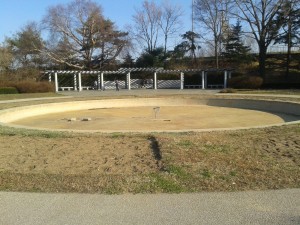I selected Shakespeare because I recently had to explain to a student why the $1.99 complete works he found for Kindle would not suffice for the work we will do in class. I was giving the standard “you need to get the books for this class ASAP” speech during our first discussion section, and I said something to the effect of “It’s ok if you have or want to use a version other than Signet, but be sure that it’s a reputable edition with good notes.” I was astonished when this student asked “What do you mean by ‘notes’?” I tried to explain the necessity of footnotes glossing words that persist in current usage but had different meanings during the early modern period. Later, the student emailed me a link to Amazon’s page for the edition he had, asking if I thought it was good enough. He said “I don’t see anything obviously wrong with it other than that it has no notes.” I saw something else wrong with it: It did not list the name of the editor or contain any textual information or any clues as to the principles by which the text was prepared. I used King Lear as an example. The text as we have it comes from two sources (the 1608 Q1 and the 1623 F1) and so an editor must either print one of those or conflate the two. When I pointed out that – in the absence of any editorial notes identifying what was on his electronic pages – he might end up reading something very different than what the rest of the class was seeing, he decided to buy the recommended print edition. (I didn’t even get into variations between copies of those early printings.)
I’m sharing this story because it seems that this student is exactly the sort of reader whom makers of electronic texts hope to reach: he wanted something both inexpensive and reliable. He just didn’t find the information to evaluate whether or not the Kindle product at which he was looking answered his needs.
So, King Lear.
I started with Project Gutenberg. I thought it interesting that ssing the “search” feature yields a disorganized mess that uses “by popularity” as the default ordering system. I tried again by browsing. Under Shakespeare’s author heading, one may find four texts for King Lear. The first is helpfully accompanied by “Scanner’s notes” explaining that it is a reproduction based on the first Folio and pointing out that different copies of F1 differ from each other. The scanner (who sounds like an editor) provides his rationale for spelling alterations and gives his name and email addresses, encouraging readers to contact him if they find mistakes or disagree with his choices. This seems sound, but I am bothered by the “Executive Director’s notes” that precede the “Scanner’s notes.” That note reads as follows:
In addition to the notes below, and so you will *NOT* think all the spelling errors introduced by the printers of the time have been corrected, here are the first few lines of Hamlet, as they are presented herein:
Barnardo. Who’s there?
Fran. Nay answer me: Stand & vnfold
your selfe
Bar. Long liue the King
***
As I understand it, the printers often ran out of certain words or letters they had often packed into a “cliche”. . .this is the original meaning of the term cliche. . .and thus, being unwilling to unpack the cliches, and thus you will see some substitutions that look very odd. . .such as the exchanges of u for v, v for u, above. . .and you may wonder why they did it this way, presuming Shakespeare did not actually write the play in this manner. . . .
The answer is that they MAY have packed “liue” into a cliche at a time when they were out of “v”‘s. . .possibly having used “vv” in place of some “w”‘s, etc. This was a common practice of the day, as print was still quite expensive, and they didn’t want to spend more on a wider selection of characters than they had to.
You will find a lot of these kinds of “errors” in this text, as I have mentioned in other times and places, many “scholars” have an extreme attachment to these errors, and many have accorded them a very high place in the “canon” of Shakespeare. My father read an assortment of these made available to him by Cambridge University in England for several months in a glass room constructed for the purpose. To the best of my knowledge he read ALL those available . . .in great detail. . .and determined from the various changes, that Shakespeare most likely did not write in nearly as many of a variety of errors we credit him for, even though he was in/famous for signing his name with several different spellings.
So, please take this into account when reading the comments below made by our volunteer who prepared this file: you may see errors that are “not” errors. . . .
So. . .with this caveat. . .we have NOT changed the canon errors, here is the Project Gutenberg Etext of Shakespeare’s The Tragedie of King Lear.
Michael S. Hart
Project Gutenberg
Executive Director
This is a very peculiar appeal to authority. While it is good that Hart wants readers to understand something of the wobbly nature of early modern spelling practices, he is more or less claiming that we should trust the contents of Project Gutenberg’s books because the Executive Director of the company had a well-read father and is telling us that he knows what he is talking about. As a scholar, I find it offensive to be called a “scholar” by Hart. I do not need scare quotes, thank you very much. His overt meaning is that one does not have to be an expert to make sound judgments about texts (which is, after all, the ideal toward which open access strives), but his implication is that experts are actually mucking up the process of letting people understand the play by nostalgically clinging to insubstantial quibbles. Needless to say, this edition is not annotated. As an attempt to faithfully reproduce the text of F1, it could have uses to some people (such as scholars who already have some understanding of what to expect, and would not need to lean as heavily on the notes as would a beginner), but Hart’s note could steer people away from more helpful formats for their needs.
Next, I tried Google Books. A search for King Lear produced “ About 2,740,000 results.” Following Duguid’s point that Google’s sorting is a powerful force on the reader who does not know what he or she is seeking, I decided to investigate the first hit. It was the “Dover Thrift Study Edition” which contained word-definition footnotes. The copyright page (which was visible in the preview) explains that Dover has reproduced “the unabridged text of King Lear, as published in Volume XVII of The Caxton Edition of the Works of William Shakespeare, Caxton Publishing Company, London, n.d.” which is accompanied by a study guide made by test prep company R.E.A. and notes that “were prepared” for Dover by a nameless editor. Yes, they did indeed cite “n.d.” instead of – for instance – checking WorldCat to determine that the Caxton edition was published in 1910. I thought I’d try again, but this was a mistake.
The first free edition in the listings is from 1808 and is keyed to performance at Drury Lane and Covent Garden. There are some scanning oddities, but those are minor in comparison to the real problem:
THIS IS THE HAPPY ENDING VERSION.
It was dreadful (though popular) enough when Nahum Tate decided to “improve” (scare quotes warranted) the play for the tastes of the Restoration stage, but for Google Books to offer this version without a prominent disclaimer is unconscionable. A version of the play in which Lear and Cordelia live happily ever after could appropriately be called a work “based on” or “inspired by” Shakespeare’s play, but this IS NOT Shakespeare’s play. Google is doing its readers a major disservice and doesn’t even have the decency to give a person’s name to whom we can complain about shoddy (lack of) cataloguing.
Searching HathiTrust, the first item I found is the New Variorum Shakespeare edited by Horace Howard Furnace, Ph.D., L.L.D and published in 1880. It appeared to be a fine, responsibly-prepared edition that reflects the critical tendencies of the nineteenth century. The notes consist largely of collections of famous critics’ opinions about the text, but – as they are well marked as such – unlikely to offer serious trouble to the beginning reader. There were many fingers, slightly crooked pages, and corner shadows in the scanned images, but I found that the clarity of the text and flexibility of the online viewer made it more pleasant to read than the other scanned versions I found. While the old-fashioned, ivory tower model of scholarly authority was clearly present in this edition, I think that, of the ebooks I’ve discussed here, this would be the most helpful to a beginner because at least it clearly represents itself for what it is. The multiplicity of the notes (which may look a bit daunting at first – but the reader would find a similar landscape if she wandered into a bookstore and picked up the modern Arden Shakespeare) draws attention to the fact that editors make choices in presenting texts; the first-hit items from Project Gutenberg and Google Books did not. HathiTrust’s site layout is more user-friendly than Project Gutenberg’s and its sorting principle is likelier to lead the reader to something useful on a first try than is Google Books.
After this research, if I had the conversation with which I began this post to do over again, I would still advise my student that it would be much easier to spring for the $4.95 Signet Classics Lear in physical form









